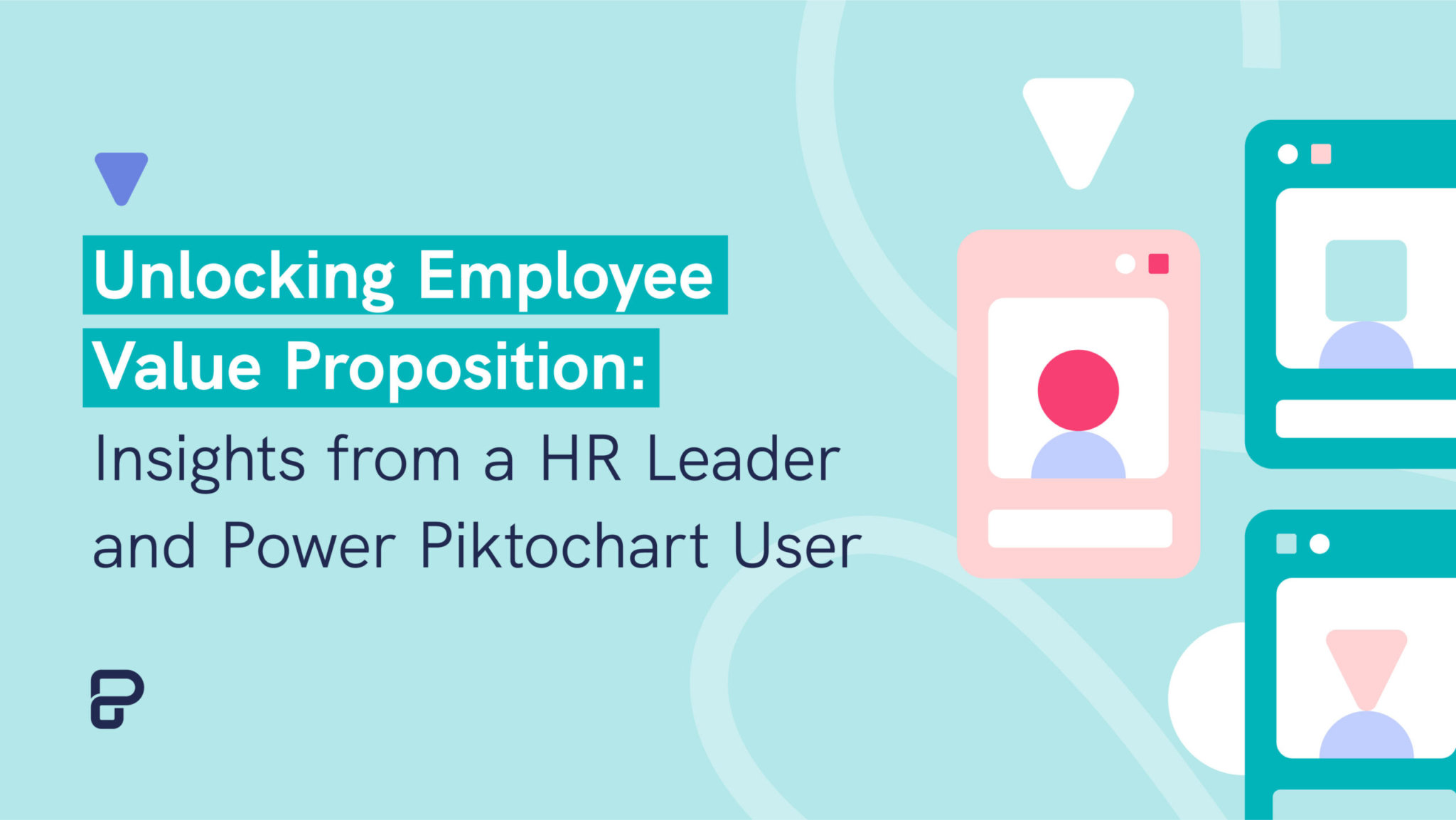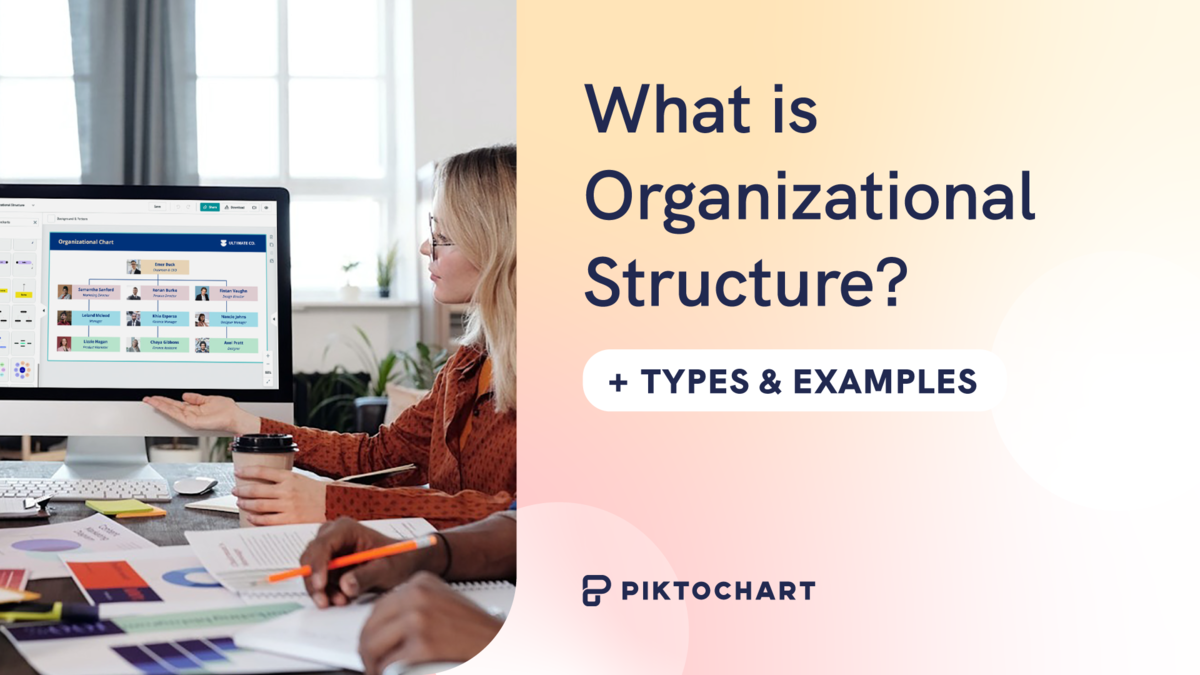We recently spoke with Diana Le, a Human Resources Leader at Tenaris, and she made it clear: a good Employee Value Proposition (EVP) can make all the difference. Diana underlines the importance of leveraging the benefits that Tenaris employees already have, making them lively participants in the organization.

In addition, the EVP plays a critical role to foster employee engagement, retention, and decrease annual employee turnover. By understanding the comprehensive value employees get from their work, Tenaris motivates its folks to keep contributing and thriving within the organization.
Together with Diana, we’re going to dive deeper into what a company’s employee value proposition is and why it matters for your organization.
Piktochart is a visual communications tool catered to your business needs. Sign up for free to access visually-appealing templates for presentations, reports, and more, and easily personalize within minutes. No extra steps involved.
Table of contents
What is an Employee Value Proposition (EVP)?
An Employee Value Proposition (EVP) is about the balance of rewards and benefits offered to employees in return for their performance on the job. When effectively defined and communicated, it drives an organization’s ability to attract, retain, and engage top talent.
Diana agrees – a compelling EVP can give potential and current employees a strong reason to choose and stay with an organization over competitors in the labor market.
Elements of Employee Value Proposition
An effective Employee Value Proposition (EVP) typically includes several key components:
Traditional benefits
- Compensation
This includes the employee’s base salary, bonus potential, and any other financial incentives an organization offers, such as stock options or profit sharing. These can be benchmarked against other organizations in a similar industry. - Benefits
Beyond financial rewards, tangible benefits can encompass health insurance, retirement plans, paid time off, paid parental leave, tuition reimbursement, and any other non-wage perks that can contribute to an employee’s overall package.
However, in modern times, it’s not just a paycheck that employees expressed that they’re looking for.
Non-traditional benefits
- Career Development Opportunities
This covers learning and development opportunities to grow within the company, including training and development programs, mentorship, career progression opportunities, and continuous learning initiatives for personal growth. - Work-Life Balance
This element is about the company’s culture and policies concerning flexible working hours, work hours, remote work options, vacation policies, and any initiatives to ensure employees can maintain a balance between their professional and personal lives. - Work Environment/Culture
This includes the organization’s culture, leadership style, mission, values, and work atmosphere. It’s about how employees feel when they are at work (refers to both physical and psychological safety), which can include aspects such as the level of teamwork, respect, diversity and inclusion, and positive relationships in the workplace. - Social Impact
In recent years, most employees are looking to work for organizations with corporate values that contribute positively to society. This can include corporate social responsibility programs, volunteer opportunities, sustainability initiatives, and ethical business practices.

10 Strong Employee Value Proposition Examples
1. Tenaris
Tenaris focuses on a culture of innovation, continuous learning, and collaboration. Its employees enjoy the opportunity to work on global projects and interact with a diverse workforce, providing rich experiences and perspectives. In addition, Tenaris prioritizes safety and sustainability, fostering a work environment where employees’ wellbeing is paramount.
2. Starbucks
Starbucks offers a unique EVP, with benefits such as comprehensive healthcare, stock options, and a free pound of coffee each week. But perhaps most famously, Starbucks offers tuition coverage for a first-time bachelor’s degree through Arizona State University’s online program.
3. L’Oreal
L’Oreal’s EVP is centered on their commitment to fostering creativity and innovation among their employees, with opportunities for career advancement and skill development. They also have a strong emphasis on ethics, responsibility, and diversity and inclusion.
4. Johnson & Johnson
Johnson & Johnson’s EVP, known as “Our Credo,” prioritizes the needs and well-being of the people they serve. They focus on innovation, collaboration, and career development, with a strong emphasis on work-life balance and overall employee well-being.
5. The Boston Consulting Group (BCG)
BCG’s EVP focuses on impactful work, diverse and talented colleagues, an empowering environment, and unparalleled opportunities for career progression. They highlight their commitment to social impact and maintaining a diverse and inclusive workplace.
6. Procter & Gamble (P&G)
P&G’s EVP focuses on trust, integrity, leadership, ownership, and passion for winning. They also provide their employees with meaningful work, personal and professional growth opportunities, and a competitive compensation and benefits package.
7. Google
Along with competitive salaries and benefits, Google provides a fun, innovative, and collaborative work environment. Their offices are famously filled with amenities such as free food, gyms, and relaxation spaces. They also foster a culture of learning and career progression, as well as work-life balance and flexibility. Google’s EVP is not just about its perks, but also about its commitment to innovation and making an impact in the world.
8. Microsoft
Microsoft offers a comprehensive EVP that emphasizes innovation, opportunities for growth and impact, a flexible and diverse work environment, competitive benefits, and programs that support employees’ physical and mental well-being. They also focus on social responsibility and empowering employees to make a difference.
9. Salesforce
Salesforce is known for its ‘Ohana’ culture, which means ‘family’ in Hawaiian. Salesforce’s EVP emphasizes mutual trust, customer success, innovation, and equality. They also strongly emphasize giving back to the community, with employees given seven days off per year to volunteer.
10. Netflix
Netflix’s EVP emphasizes a company culture of freedom and responsibility. They offer competitive salaries and a ‘no rules’ policy, where there’s no set working hours or vacation policy, but employees are expected to act in the company’s best interests. Netflix also highlights their culture of candid feedback, valuing people over process, and promoting innovation.
Each of these companies has developed an effective EVP that matches their brand and mission and reflects the unique elements they offer to their employees. They have used their EVPs effectively to attract and retain the best talent in their respective industries.
Best practices to communicate employee value proposition
Plan it out, do not overwhelm the employees
Diana mentioned that her team members value diverse benefits. To keep everyone updated, Diana sends 1-2 friendly emails per month so that she doesn’t inundate the employees’ mailbox.
Align on a communication calendar
At Tenaris, they have a practice to align with a communication calendar. For instance, in May, they focus on mental health, planning their communication ahead of time, and weaving it with the benefits they already offer.
“If the compensation cycle is on the horizon, benefits communication is aligned towards financial wellness. We ensure that the right hand knows what the left hand is up to!” she adds.
Creating awareness about existing benefits
“At Tenaris, we provide our employees with a plethora of benefits; from insurance to increased parental leave, and beyond. To improve EVP? It’s not always about adding new benefits. We ensure that all our employees are aware of these perks and have access to them.”

She’s quick to add, “However, we recognize that different employees have different needs and interests. That’s why we make sure to cater our communication in a way that’s inclusive and engaging for everyone. Whether you’re a new employee just learning about our benefits, or existing employees looking to make the most of them, we’ve got you covered.”
Meet the employees where they’re at
Sometimes, HR professionals forget that others may not be as familiar with company benefits as we are. Recently, Diana visited different sites and met with various HR teams.
What she found was interesting – each team valued unique aspects and preferred different styles of communication.
This extends to generational differences, where not everyone adopts digital communication at the same pace. As HR professionals, our role includes catering to diverse roles and effective communication that resonates with each group.
Communication for everyone
Diana added that she was taken aback, but discovered that printed flyers did the trick for their hourly employees who attended townhall meetings. These handouts proved to be a valuable resource that employees could take back with them.
In today’s digital age, where most communication happens via email and intranet, it’s easy to overlook those who prefer a lower technology approach.
To bridge this gap, they also use WhatsApp groups and Microsoft Teams channels to create a sense of community, like sharing lunch options or after-work soccer matches. All of these intangible elements contribute to fostering a more closely-knit Tenaris team.
What should leaders do?
When asked this question, Diana said, “Employee value propositions are a tricky thing. Employees value different things.” Here are her few tips she wished she knew about EVP and the communication of it within the company.

- Plan out the entire year. Alternate the “traditional” things that you see such as value, health, retirement, compensation and mix them with childcare, mental health benefits that may appeal to certain groups of people.
- Meet with the teams to find out what are the values they value. We may think that employees know who’s behind the email” but sometimes, they don’t. Conduct focus groups, employee surveys, or meet them on site to find out. The organization is like a vast and living organism. There is a lot to learn!
- Consider all types of employees. In her case she has to take into account that there are generational differences, cultural preferences, salaried and hourly employees, multiple worksites, and many states. Some may have adopted digital practices quickly, while others are still working on it.
FAQs
How do you evaluate the effectiveness of your EVP?
Each of the EVP benefits that has been communicated usually has a timeline associated with it. For example,
- Performance management process – metrics can be monitored through the performance management platform. Once the email/communication is sent, does it correspond with an uptick in the number of people checking it out?
- Mental health – which is covered by insurance – Tenaris works with a support tool for employees to schedule virtual mental health visits with licensed providers etc. Has the communication driven more employees to make use of it?
- Parental leave – is not something that she can witness immediately. However once communications are sent, she does get employees directly contacting her with questions.
In short, the mechanism to track metrics does not have to be overly complex. It’s sufficient to see a corresponding success of the individual campaigns.
What is the difference between EVP and employer brand?
Employer Brand: The employer brand refers to the company’s reputation as an employer in the job market. It’s how the organization is perceived by both its current employees and potential employees. The employer brand communicates what it’s like to work for the company, including the company’s values, culture, and mission.
The EVP and employer branding are closely related and influence each other. A great employee value proposition can help build a positive employer brand because it makes a company more attractive to prospective and current employees. Conversely, a strong employer brand can enhance the perceived value of the company’s strong EVP itself.
What is a common mistake that employers make when creating their own employee value proposition?
You don’t have to create new benefits. You can benchmark yourself against other companies, but chances are, your organization already has its unique set of benefits. It’s more about figuring out the story and how to communicate and reinforce this regularly among employees.
Give Piktochart a try for more communication resources. Get started for free.




